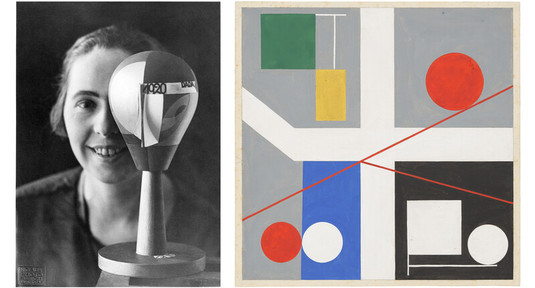A friend informed me about a Swiss dada-pioneer. Here she is (Ted Loos in NYT):
‘In 1937, the Swiss artist Sophie Taeuber-Arp wrote a letter to a friend, noting her exclusion from an avant-garde exhibition in Paris. While a male Belgian artist in her circle was refused entry too, “as a woman it is ten times harder to hold your position in this caldron.”
And therein lies a tale, one that may be receiving an updated ending. Taeuber-Arp (1889-1943), a pathbreaking artist, is the only woman on a Swiss bank note, and she has been featured previously in major museum exhibitions. But her name is hardly bandied about — certainly not with the frequency of her husband’s, Jean (Hans) Arp — and some influential people in the art world are collectively looking to change that.
Among her advances was using interior design as an artistic tool, an early version of installation art, and when she wasn’t painting she made textiles, costumes and sculptures and edited magazines. She was a dancer, too.’
(…)
‘“People always ask why she is not more known,” said Iwan Wirth, Hauser & Wirth’s co-founder, who is Swiss himself. “She’s one of the great known-unknown artists of the century.” He added, “She’s on the 50 franc note, but still many people in Switzerland don’t know who that is.”’
(…)
‘Mr. Hartog, who is also the director of Gerhard-Marcks-Haus in Bremen, Germany, has spent much time in the couple’s archives. Having a renowned artist for a husband and collaborator helped ensure that her work would be known to a certain degree — but also overshadowed. “She was a strong woman in a milieu of modernist males,” he said.
Mr. Hartog pointed to a famous 1928 collaboration of the Dutch artist Theo van Doesburg with Arp and Taeuber-Arp for the design of L’Aubette, a leisure complex in Strasbourg, France, meant to be a complete work of art and a showplace for the new de Stijl movement.
“I’m a Dutch art historian, and when we learned about this in school, we were told it was by van Doesburg, who brought his friend Arp, who brought his wife,” Mr. Hartog said. “She was unnamed.”
Taeuber-Arp, he added, “made the color scheme for one of the spaces.” “She was one of the first artists in Europe who understood that with color, you can make space,” he said.’
(…)
‘“From reading her letters, and letters from people who knew her, my impression was that she was friendly and organized,” Mr. Hartog said. “Hans was more impulsive.”
If Arp was sensibility, Taeuber-Arp was sense.
Mr. Hartog quoted a letter that Taeuber-Arp wrote to her husband in 1919, when the Dada movement was at a fever pitch, with its devotees penning manifestoes left and right:
“I’m furious. What is this nonsense, ‘radical artist.’ … It must only be the work, to manifest oneself this way is more than stupid. … Nobody cares if you’re always hopping around on your vanity like this.”
The Los-Angeles based artist Christina Forrer, who is Swiss and makes tapestries among other works, said she had always admired that Taeuber-Arp was “unpretentious,” attributing it at least partly to heritage. “Swiss Germans aren’t flowery,” she said.’
Read the article here.
If Swiss-Germans aren’t flowery, I’d love to be Swiss-German, maybe I’m already Swiss-German. Who knows who you really are.
And she is right, wherever the word ‘radical’ pops up vanity is not far away, or maybe slightly worse, politics is not far away, that other vehicle for vanity and idolatry.
